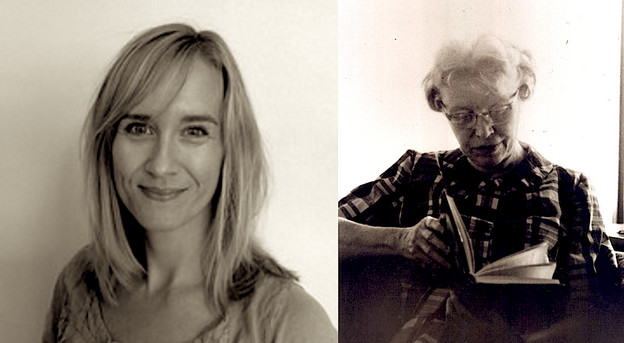
First reading of Lorine Niedecker's 'Popcorn-can cover' (3)
Mandy Bloomfield

Popcorn-can cover
screwed to the wall
over a hole
so the cold
can’t mouse in
— Lorine Niedecker
When I first encounter a poem as concise and object-like as this one, the impulse is to look before I read. And because this looking doesn’t tend to proceed in a reading direction (left-to-right, top-to-bottom) the first thing I notice about Niedecker’s poem is the indentation of the fourth line. From there, my eye is drawn to the word “hole” in the line above, and this verbal-visual articulation leads me to understand that the indentation performs a state of perforation; its left margin isn’t sealed; the poem orients itself around a gap. Or perhaps a portal: a way in.
Indeed, when I come to actually read the lines, left-to-right, top-to-bottom, this initial response makes sense in relation to the act of improvised patching-up upon which the poem focuses. To mend a hole in a wall with a piece of waste packaging is a practice of bricolage, making creative use of whatever is at hand, to paraphrase Levi Strauss’s well-known formulation. In this case, it is surely an art of necessity that emerges from privation. Both the “hole” (the lack) and the resourceful attempt to “cover” it are rendered visible, operative, present in this practice, as in the poem.
Now I realize I’m drawing on the sense of Niedecker’s work and life that I’ve already formed, though it’s a little hazy at this point. I’m reminded of the “bare walls” and the struggle over property in another of her poems, “Foreclosure” and of the poet’s life of hard work and poverty. But this is not necessarily to impose a biographical reading on the work. For me, Niedecker’s is a poetry of close observation, often of the details of everyday life, and most especially a life positioned semivoluntarily on the margins (geographically, socially, and in terms of poetic communities).
Niedecker’s relation to what Rachel Blau DuPlessis and Peter Quartermain have called the “objectivist nexus” begins to seem relevant here. I’m reminded of Zukofsky’s epigraph to his 1931 “Program: ‘Objectivists’”: “An objective (Optics) — The lens bringing the rays from an object into focus.” The optical metaphor is important in relation to Niedecker’s poem, I think, particularly because of the kind of “object” whose “rays” it brings into focus. The poem pays scrupulous, intimate attention to a small patch of material reality that might not normally be attended to at all, let alone made the focus of aesthetic attention. The poem asks us to invest perception in, to dwell upon, that which might otherwise be peripheral, unnoticed, invisible.
And so to return to the particulars of the poem’s “object” (and to the poem as “object”). A “Popcorn-can cover” would usually be considered waste, but here it is made use of, both as a home-improvement material and aesthetically. I find myself wanting to know exactly what such an object would be made of in the mid-1960s when the poem was written. I don’t have much of a grasp on the history of packaging, but I’m supposing that convenience, throwaway packaging was becoming more ubiquitous at this time, although not to the extent that we now see in our contemporary single-use world. Nevertheless, this appropriation and recycling of an object that would normally be considered abject seems to me to espouse a sensibility of revaluing (or just plain valuing) unappreciated or discarded aspects of the material world (objectivism as “abjectivism”?). Moreover, the “Popcorn-can cover” takes on emphatic aesthetic value as poetic material; it “pops” with plosive consonants and short vowel sounds; it crackles with auditory energy. And yet that it is “screwed to the wall” signifies a process of arrest, both in the action described and in the longer, drawn-out sounds of this line.
Of course, the popcorn-can cover itself becomes appropriated for the purposes of arrest or obstruction, “so the cold/ can’t mouse in.” The use of “mouse” as a verb here is so striking and unusual. When used as a verb, this word customarily refers to hunting cats. But Niedecker uses it to ascribe a mouse-like quality to draughts infiltrating the dwelling place from outside. Consequently, the cold takes on a mammalian agency, wriggling through the boundaries we construct between inside and outside. And yet this (oddly warm-blooded) quality renders it not-entirely “other.” There is a sense here of dwelling as coexistence and permeability to nonhuman forces. This is definitely not a blissful and idyllic oneness with the natural world, but it is nevertheless a recognition of nonhuman entities as possessing agency, or an acknowledgement of what philosopher Jane Bennett refers to as “vital materiality.”
Niedecker does not so much “capture” this agential force as allow it into her work. Although this poem ostensibly focuses on an act of attempting to keep out the “mousing” intrusions of the outside, the work itself embodies an openness, and careful attention, to “vital materiality.”
I could say more. But now I’m eager to go away and read other things. I want to look at other Niedecker poems; I want to revisit articles on Niedecker by Rachel Blau DuPlessis and Peter Middleton that I read some time ago, which I know will sharpen my sense of Niedecker’s poem; I want to reread bits of Jane Bennett’s book Vibrant Matter. But that would be moving past the initial stages of encountering a poem for the first time. My first reading is full of holes and rubbish. But it’s been such fun.
* *
Mandy Bloomfield is a lecturer in English at the University of Plymouth (UK), where she teaches modern and contemporary literature. She is the author of Archaeopoetics: Word, Image, History (Alabama UP, 2016), as well as numerous articles on poetics in journals such as Contemporary Literature, Textual Practice, and Green Letters.